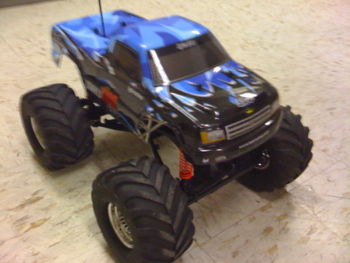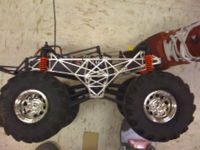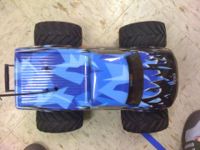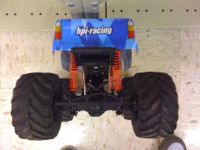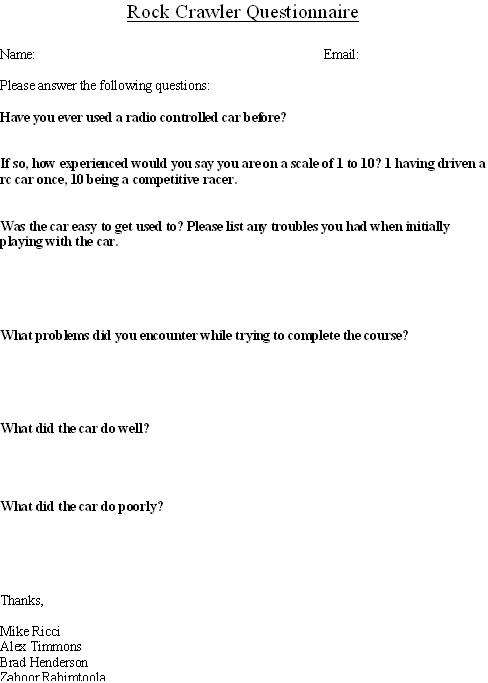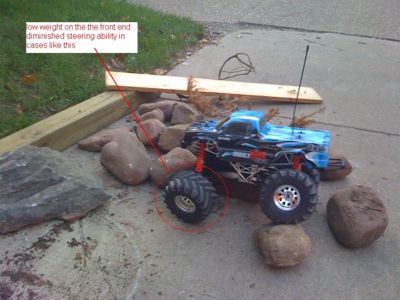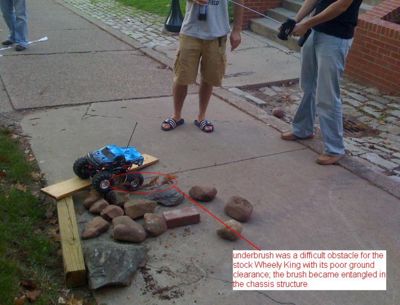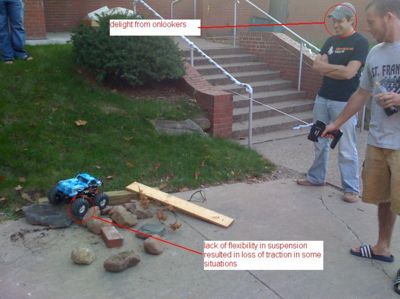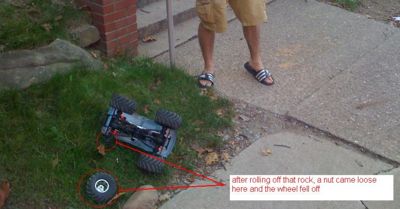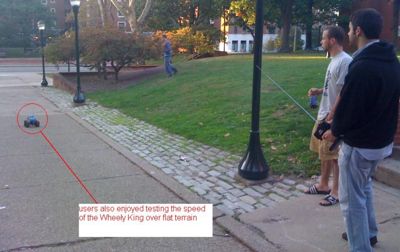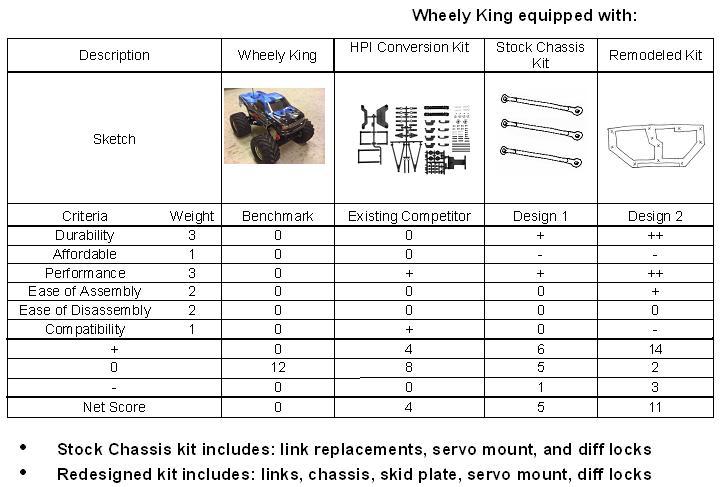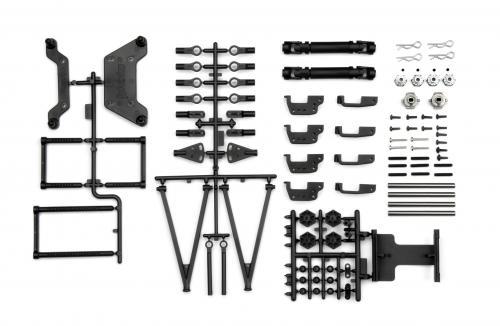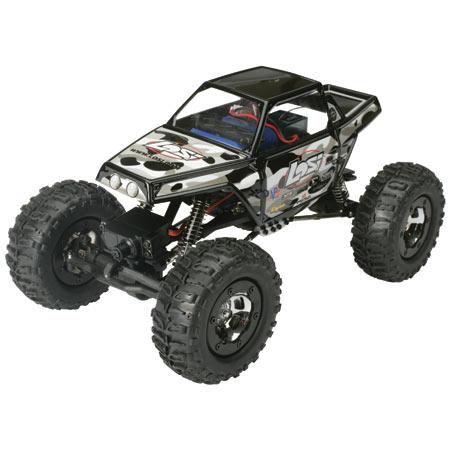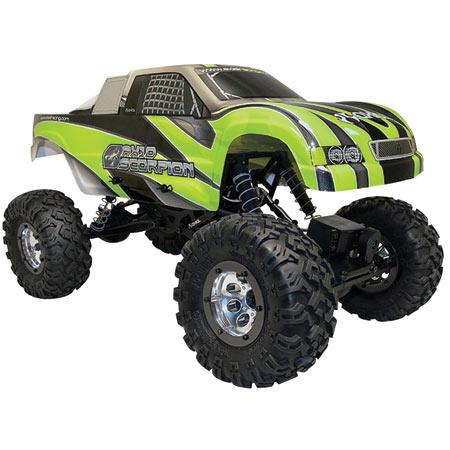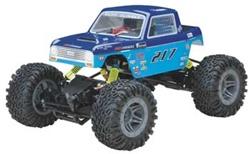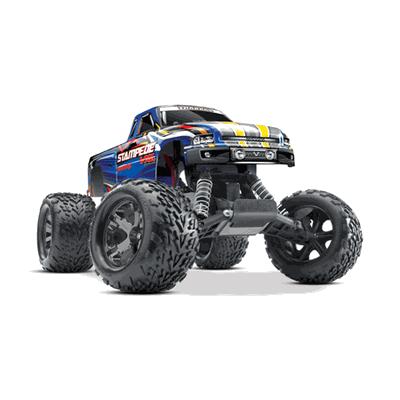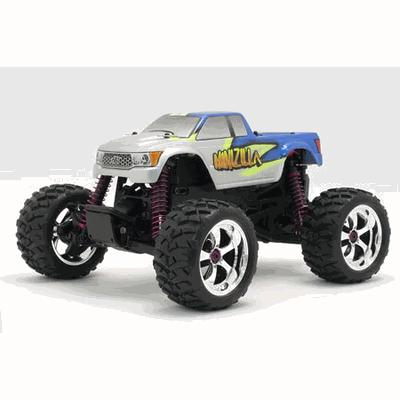RC rock crawler truck redesign
From DDL Wiki
(→Wheely King + HPI conversion kit) |
(→Concept Evaluation) |
||
| Line 64: | Line 64: | ||
Using a Pugh chart, we were able to asses our design concepts in comparison with existing products. This also showed us the positive and negative points between each characteristic of each design choice. When evaluating each design, we took into account criteria that were important to the manufacturer, and more importanly, the consumer. These criteria are weighted in accordance with our groups opinion as to how important they should weigh in the selection of the proper design. The picture below is our Pugh chart comparing the different products. First seen is our benchmark product, the off-the-shelf Wheeley King. The next product compared is an existing kit provided by HPI made for our truck. This product it mainly plastic components with very few parts made out of durable materials. Next in the chart are our two desgin concepts. The second concpet varies from the first as it has a new chasis and skid plate. Our team then evaluated each of the concepts as if they were in use on the truck. From our evaluations, the chart shows that the our second design concept with the chasis and skid plate offer us the best solution, and therefore this concept will be the one we choose to investigate further. | Using a Pugh chart, we were able to asses our design concepts in comparison with existing products. This also showed us the positive and negative points between each characteristic of each design choice. When evaluating each design, we took into account criteria that were important to the manufacturer, and more importanly, the consumer. These criteria are weighted in accordance with our groups opinion as to how important they should weigh in the selection of the proper design. The picture below is our Pugh chart comparing the different products. First seen is our benchmark product, the off-the-shelf Wheeley King. The next product compared is an existing kit provided by HPI made for our truck. This product it mainly plastic components with very few parts made out of durable materials. Next in the chart are our two desgin concepts. The second concpet varies from the first as it has a new chasis and skid plate. Our team then evaluated each of the concepts as if they were in use on the truck. From our evaluations, the chart shows that the our second design concept with the chasis and skid plate offer us the best solution, and therefore this concept will be the one we choose to investigate further. | ||
| - | [[Image: | + | [[Image:Rock_crawler_Pugh3.JPG|800px]] |
=Appendix= | =Appendix= | ||
Revision as of 21:24, 8 October 2008
Executive Summary
This stage of our project required our group to analyze opportunities for improvement. We went about collecting data and observations in many various ways in order to diversify our understanding of the problems. Our first action towards product improvement was a basic brainstorming session where our group came up with 100 possible ideas from improvement, ranging from technical improvements such as higher torque to aesthetic changes such as having colored wheels. We wanted our improvements to intrigue both the amateur and the professional.
Next, our group conducted novice testing. In order to expand our consumer market base we have decided to create a product that can be used by everyone, not just the professional. In order to examine novice consumer needs, a 10 foot long rock crawling course was constructed. The course consisted of varying sized rocks followed by an incline. All participants were asked to fill out a questionnaire regarding their experience. (i.e.: what problems did you encounter while trying to complete the course?) From this data we realized that the most common problems for the amateur user was the car flipping over.
In order to obtain findings on a professional level, our group went to an indoor rock crawling facility. Two hours were spent watching competitions and talking with professional rock crawlers. Here we obtained more detailed findings that were all technically related. We talked to five professionals throughout the time spent at the facility, all having a very good knowledge of the HPI Wheely King. For the professional, the main problems with the stock Wheely King are its poor weight distribution, flimsy parts, and lack of a locked differential.
From all of the data and user opinions collected over the last three weeks our group was able to come up with …..x…..design improvements which we studied through the use of a Pugh chart. Brad/Zahoor….. can you put 2-3 sentences here about the pugh chard……From this study we concluded that ……….. are the best design improvements b/c…..
Research and Observations
For our research, we decided to get as many varying opinions as possible. We wanted to know what the novice thinks of the original car as well as a professional. (For the sake of simplicity, we decided to call anyone that competes at rock crawling a professional) For the novice research, our group set up a simple course that every participant was instructed to use. The course was 10 feet long and consisted of varying sized rocks as well as a slippery incline. The goal was to make it across the course without flipping the car or having to use reverse. Time was not a measured factor. Each participant was given 2 minutes before attempting the course to familiarize themselves with the car. After completing the course the participants were then asked to fill out a questionnaire so we could obtain feedback on the cars performance. From our novice research we found that the most common problem was the car tipping. The second most common problem was the need to reverse because the car could not climb over bigger rocks. This suggests to us that the car needs to have a more flexible chassis in order to keep its balance when going over uneven surfaces.
For our professional research our group went to an indoor rock crawling facility located in Beaver Falls, Pennsylvania. We were invited by the owner of the hobby shop where we purchased our car. The facility was an empty warehouse that was rented out for the weekend. We spent two hours at the facility watching competitions and talking with numerous professionals. As we had previously thought, everyone in the facility knew of the HPI Wheely King and everyone was quick to offer their opinion of the car. It was the general consensus that it was a good base model to transform into a rock crawler, but had some distinct flaws. Everyone first mentioned its weight imbalance, saying that a car designed to do wheelies is not designed to crawl rocks or go up steep inclines. Second, its flexibility was mentioned, saying that it had decent flexibility for a stock model but needed more axle freedom in order to climb the larger rocks without flipping.
Overall our research was very beneficial. We were able to identify the needs of both the amateur and the professional, giving us the advantage of designing an improvement kit that can be sold to a very diverse market. As well as being able to identify needs, our research provided us with professional advice that is now directing us to an improved product.
User Study
Design Concepts
Servo Mount
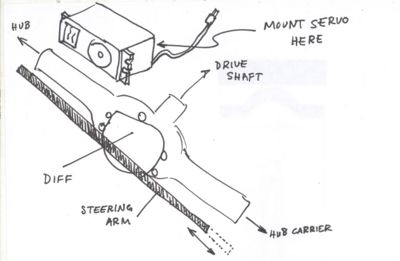
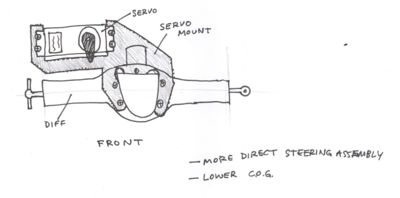
On the stock Wheely King, the servo is mounted to the chassis toward the top, behind the front shock tower. The steering power, is translated to the front differential through a five part linkage. The weight of the servo and linkage components is not necessary to have up top (poor effect on COG) when we can mount the servo elsewhere, lower on the truck. By mounting the servo directly above the steering rod, on the differential, we can lower the COG a great deal.
Another disadvantage to having the servo connected through a linkage is that any deformation in the linkage components results in inaccurate steering. Many times in rock crawling, the steering system will have to overcome large load, such as when the trucks weight rests on the side of the front wheels. With the servo connected more directly through a one part linkage as opposed to a five part linkage, the steering system has greater strength. Reducing the part count is a good thing in this case as the added components can only introduce more modes of failure or weaken the steering system.
Redesigned Chassis
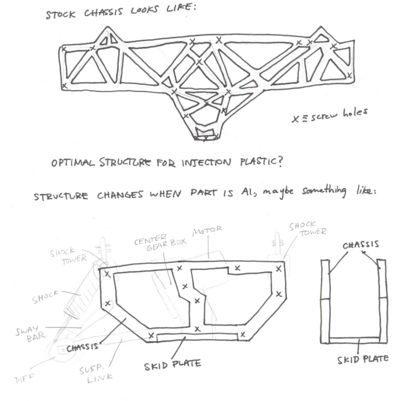
Many major component assemblies are attached to the chassis. The center gearbox and battery housing, for example, are two high-mass assemblies whose positions are dictated only by the anchor points to the chassis. By redesigning the chassis and moving these components around as we wish, we can lower the truck's COG without compromising ground clearance. The improved chassis can also facilitate the extension of the wheelbase, further increasing the vehicle's stability.
Manufacturing the chassis from machined aluminum plate can be accomplished realistically with either manual milling for prototypes or CNC milling for large batch production. Aluminum has many advantages over plastic in this application. The increased strength of the metal allows much less material to be used while still increasing overall chassis rigidity.
Sway Links
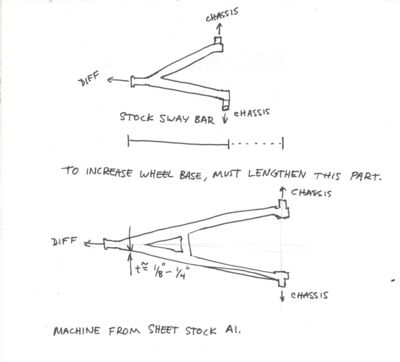
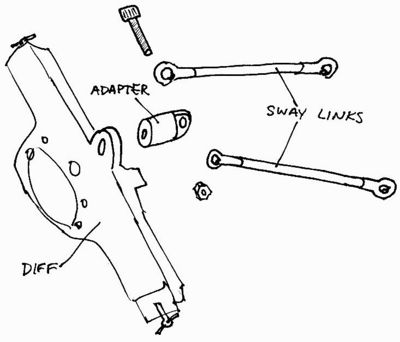
In order to lengthen the wheelbase, the sway bars must be replaced as well. This could be accomplished with machined plate aluminum, but the alternative we'll more likely choose is to design a small adapter component that will allow us to use aluminum rod and ball-pivoting rod ends. These can be the same materials as will be used in the suspension links and steering components. In this case, increasing the part count makes sense because we can reduce the amount of machining required for our components; rod and rod ends will be much easier to implement.
Concept Evaluation
Using a Pugh chart, we were able to asses our design concepts in comparison with existing products. This also showed us the positive and negative points between each characteristic of each design choice. When evaluating each design, we took into account criteria that were important to the manufacturer, and more importanly, the consumer. These criteria are weighted in accordance with our groups opinion as to how important they should weigh in the selection of the proper design. The picture below is our Pugh chart comparing the different products. First seen is our benchmark product, the off-the-shelf Wheeley King. The next product compared is an existing kit provided by HPI made for our truck. This product it mainly plastic components with very few parts made out of durable materials. Next in the chart are our two desgin concepts. The second concpet varies from the first as it has a new chasis and skid plate. Our team then evaluated each of the concepts as if they were in use on the truck. From our evaluations, the chart shows that the our second design concept with the chasis and skid plate offer us the best solution, and therefore this concept will be the one we choose to investigate further.
Appendix
Concept Brainstorming
1. reverse chassis to redistribute weight to front to improve rock crawling ability
2. lengthen wheelbase to increase ground clearance
3. fabricate aluminum sway bars
4. remove rear rod balance for flexibility
5. lock differentials
6. redesign chassis to reduce fasteners and improve handling
7. reverse tires for better traction
8. down gear for improved torque
9. re-fab steering components
10. solid driving axle
11. fabricate aluminum suspension links
12. redesign suspension links (tube shaped) to increase yield stress while maintaining factor of safety
13. Additional body mounts to change body on chassis (aesthetics)
14. better esc
15. mount servos on both front and rear axles for low cg
16. increase tire weight to lower cg
17. change shock spring
18. change shock fluid
19. upgrade motor
20. cast new body
21. convert to tank tracks
22. insert memory foam into tires
23. upgrade bearings
24. upgrade steering servo
25. add solenoid to front suspension for “jumping” onto obstacles/rocks
26. bug metal gears
27. rearrange cells in battery pack for better weight distribution
28. metal wheel rims for lower center of gravity
29. get metal drive shafts
30. increase cells in batter for longer lifespan
31. bend a tube chassis
32. dual motor
33. mount servo to differential: lower COM and less complicated steering linkage
34. build tube frame chassis
35. waterproof electronics
36. remount lower sway bars for increased ground clearance
37. mount servo above knuckle for greater ground clearance and stronger steering
38. increase servo arm length
39. add functional headlights (aesthetics)
40. add spare tire in bed (aesthetics)
41. repaint body for realism (aesthetics)
42. add roof rack (aesthetics)
43. upgrade tires for better tread grip
44. use sheet metal (~1/8 in)to redesign parts (easy manufacture)
45. add sheet metal skid plates
46. substitute delrin for aluminum in places where the weight would raise the COM
47. cast another larger, more proportional body (realism, aesthetics)
48. combine upper suspension links and battery mount into one part (also moves battery) to a more desirable location
49. add rear view mirrors (aesthetics)
50. incorporate skid plate into chassis redesign
51. add ballast in tires
52. design snap fastener body mount
53. make chassis solid plate
54. make chassis of a rigid non-metal (carbon fiber)
55. make suspension and steering components of carbon fiber tubing
56. attach skid plate to front diff for steering protection
57. bend a scale brush guard
58. design adapter to fit between diff and sway bar to allow sway bar to be made of rod and rod end like the suspension links (DFMA+ for us as conversion kit manufacturers)
59. make steering linkages from rod and rod ends (also DFMA+, maybe thinner rod though)
60. zip tie electronics cords to chassis/components to keep them out of the way
61. put additional holes on redesigned chassis to allow for adjustments and to work with a larger range of existing components on the market
62. integrate plastic "windshield" into body
63. change shock spring color for aesthetics
64. design a one piece chassis
65. make wheels larger than body so it can flip over and still maintain traction
66. give a full 180 degrees of rotation between front and rear axle
67. change truck to a ball that can just roll over obstacles
68. less fasteners
69. air freshener in cab
70. missiles
71. american flag
72. missiles AND american flag
73. convert to robotic "spider" legs instead of wheels
74. attached cup holder for beverage retrieval
75. plow or cow catcher mounted to front
76. increase scale and power to provide for sidewalk shoveling in winter
77. controller that is an actual steering wheel
78. "nitrous" button on controller for increased speed
79. change to three wheel ("omniwheel") design that allows travel in any direction
80. increase battery life
81. wheels with cleats
82. tires equipped with chains for better snow traction
83. convert to half track system (two front tires and tank tracks in the back)
84. make components from reused/recycled material (green machine)
85. put a remote camera in the truck to improve performance for rock crawling competitions
86. actuated arms to move obstacles from truck's path
87. launchable cable grabber to drag itself through obstacles
88. functional winch on the front
89. aesthetic muffler or exhaust system
90. novelty "la cuca racha" horn
91. carrying case/storage box
92. cleaning kit
93. oil slick squirter
94. actuated arms on the side so it can right itself if rolled
95. add mud flaps
96. ability to do burnouts
97. place to store antenna
98. adjustable antenna to cover different ranges
99. fixed antenna
100. carbon fiber body (aesthetics)
Existing Related Products
Wheely King + HPI conversion kit
- 2 1/4in longer wheelbase for better stability
- Longest wheel base allowed by class rules
- Diff Lock (Front and Rear) for increased traction
- Front battery layout moves weight forward for better crawling stability
- Additional body mounts allow fitment of all Savage bodies
- Aluminum lower suspension links for extreme durability and good looks
- High link suspension mount brackets for more ground clearance
- New Steering servo mount repositions servo to allow battery in front of crawler
- Optional 17mm hex hub included for fitment of 17mm hex hub wheels. (Savage wheels etc.)
Price: $220 + $80 (for kit) = $300
Losi 1/18th mini rock crawler
- Metal Twin Vertical Plate (TVP) chassis design
- Multi-link crawler suspension design
- Heavy duty metal ring and pinion gears, axles and axle shafts
- Gusseted drive cases for increased strength and durability
- A true locked-out rear end design, no steering spindles
- Heavy duty universals with slide-type outdrives and metal yolks
- Alloy lower suspension links with captured ends
- Extra long oil filled shocks, front and rear
- Solid axles with optimized drive shaft angles allow for a freely-rotating driveline throughout the entire suspension travel
- Telescoping slider driveshafts
- 3-Gear center transmission with spool and slipper
- 4WD with locked differentials
- Ball bearings throughout
- 1.9 Bead lock style wheels with 12mm wheel hexes
- New electronic FWD/RWD rock crawling specific speed controller (ESC) with extra drag brake
- High-torque rock crawler specific motor
- Mini high-torque rock crawling servo
- Tuber style body: Scale looks of the full-scale rock crawling machines; 3 colors to choose from: Red, Blue and Black
- Features Mini-Rock Claw Tires for superior traction (modeled after the National Champion winning 1/10-scale Rock Claw 2.2 Tires)
- Losi LSR3000 radio system featuring Spektrum™ 2.4GHz DSM® technology for crystal-free operation
- 7.2V 1100mAh NiMH Battery and Charger
- 4 AA batteries included for transmitter
Price: $320
Axial Rock Racer 1/10th RTR Rock Crawler
- Complete ready to race/crawl out of the box
- 4WD
- 27T Electric Motor: Tear up the terrain in-door or out-doors. Easy Operation: No Tuning, No Fuel, No Loud Exhaust Noise. Just Plug'n'go!
- 20T pinion paired with an 87T spur gear gives you a quick rock racer ratio, or install the included 14T pinion for a slower rock crawling ratio
- True Beadlocks: No Messy Glue!
- Hi-quality Composite Plastic and Metals
- Durable (ESC) Electronic Speed Controller: Hi-quality durable forward and reverse speed controller
- Hi-Torque Servo help hold your line when rock crawling
- Solid Rear Axle lockouts improve ground clearance when crawling
- Slipper Clutch: Reduces gear wobble for a more efficient drivetrain. Allows a motor to work more efficiently and greatly enhances the durability of the drivetrain
- Aluminum Chassis plates with a molded nylon skid plate provide a solid and rigid chassis
- Ultra compact and lightweight transmission
- Open front diff for smaller turning radius, or install the included front locker for more traction when rock climbing!
- Rear axle is locked for better traction
- Full Ball bearings
- Overall gear ratio range from 15:1 to 74:1
- Transmission: 2.6:1; center mounted
- Differentials: Front - gear differential; Rear - locked (spool)
- Transmission: Single-speed
- Tires: Axial 2.2 Rock Lizards
- Wheels: Axial 2.2 8 Hole Beadlocks (Satin Chrome)
- Suspension: 3 Link
- Drive Shafts: Universal front and rear
Price: $ 475
Duratrax cliff climber 1/14th scale electric Rock Crawler
- Twin 380 motors deliver high turn with low RPM, for massive torque to climb near-vertical inclines and clear the largest obstacles.
- Oil-filled shocks are adjustable and come with aluminum caps.
- True full-time 4-wheel drive. A solid spool locks the hardened steel axles. No diffs mean zero slippage, for maximum traction.
- Gunmetal-colored anodized aluminum chassis sides.
- Front and rear bumpers that won't hang up on obstacles.
- 12 mm hex wheel mounting that's compatible with many other wheels.
- Tires designed specifically for crawling. An extra-soft compound enhances traction, and the foam inserts mold to the tires and *rebound slowly.
- The RTR comes with the radio, ESC and motors already installed, and the truck body is painted and trimmed in one of six colors.
- The Prebuilt lets you use your radio and ESC, and its clear body allows for total paint customization.
- Servos mounted on both the front and rear axles for low CG.
- Servo savers on both steering servos.
- Required Parts: 6-cell NiMH batteries, charger
Price: $360
Traxxas Stamplede VXL brushless Monster truck
- 65+ mph top speed on 8000mAh 3S Lipo
- Velineon Extreme Brushless Power System
- Traxxas High Current Connector
- Maxx Cable 12 gauge wire
- Velineon 3500 brushless motor
- Velineon VXL-3s fwd/rev/brake ESC
- Precision high-torque digital steering servo
- Steel internal transmission gears
- New front steering spindles and rear hubs with 5x11mm rubber-sealed ball bearings
- Precision metric hex hardware
- Included 4-position adjustable wheelie bar
- Veratile,pre-glued Talon 2.8
- all-terrain tires"
- Sinister black chrome All-Star 2.8wheels"
Price: $510
Hot Bodies Minizilla RTR Mini 4WD 1/18th Scale Monster Truck
- Radio, ESC and steering servo included
- 7.2v Battery & Wall Charger Included
- Super Stock 370 motor provides great acceleration and high speeds
- 4WD Shaft drive system
- Long travel suspension for excellent handling
- Full ball bearings provide longer battery life
- Low-maintenance gear differentials
- Wide stance for greater control
- Battery slips inside a protective case
- Stylish wheels and tires provide excellent traction
- Includes 3 pinion gears
- Painted and Trimmed Body Included
Price: $200
